Justin Welbergen (The Hawkesbury Institute for the Environment, Western Sydney University)
Brad Law (New South Wales Department of Primary Industries)

Australian Journal of Zoology
Volume 68 Numbers 5 & 6 2020
Special IssueBat research in Australasia – in memory of Les Hall (Part 2)
The introduction to this special issue of the Journal on Bat Research in Australasia (Part 2) provides an overview of the papers in the issue.
 , Nicholas J. Murray, Justin A. Welbergen, David Westcott, Adam McKeown and Richard T. Kingsford
, Nicholas J. Murray, Justin A. Welbergen, David Westcott, Adam McKeown and Richard T. Kingsford
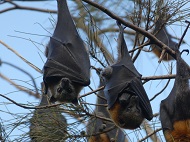
Flying-foxes typically aggregate in colonies of thousands of individuals at their roost sites, dispersing at sunset to forage on floral resources in nearby environments. In this study, we used a database of 654 known roost sites of the four flying-fox species that occur across mainland Australia. We found that the majority of roosts for each of the four species (up to 59%) occurred in land use categorised as urban. This study shows that flying-fox roosts have dramatically shifted to occur within human-modified landscapes.
Photo by Dr John Martin.
ZO20086 Abstract | ZO20086 Full Text | ZO20086PDF (467 KB) | ZO20086Supplementary Material (310 KB) Open Access Article
 , Matthew Bradford, Adam McKeown, Eric Vanderduys, Andrew Hoskins and David Westcott
, Matthew Bradford, Adam McKeown, Eric Vanderduys, Andrew Hoskins and David Westcott
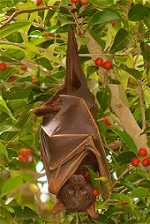
Flying-foxes often form large roost sites in urban areas, causing conflict with nearby human residents and prompting attempts to disperse the camps. We assessed roost-site characteristics of little red flying-foxes to understand if roosting habitat was limited within the species’ range. We found that increased vegetation greenness and decreased distance to water were the two most important landscape-level characteristics of little red flying-fox camp sites, and that there does not appear to be any shortage of suitable habitat in Queensland.
Photo by Stewart Macdonald.
ZO20079 Abstract | ZO20079 Full Text | ZO20079PDF (3.4 MB) Open Access Article

The permanent exclusion of flying-foxes from camps (camp dispersal) near human settlements is a management tool commonly used to mitigate human–wildlife conflict. Our aim was to review the costs and outcomes of 48 camp dispersals in Australia and improve the information base on which camp management decisions are made. We conclude that camp dispersal is a high-risk, high-cost tool for mitigating human–wildlife conflict, in situ management strategies and tools should be developed, and evidence-based information on management options should be made available to stakeholders via a nationally curated resource library.
Photo by Matthew Mo.
 , Kathryn L. Batchelor, Matt Bradford, Adam McKeown, Stewart L. Macdonald
, Kathryn L. Batchelor, Matt Bradford, Adam McKeown, Stewart L. Macdonald  and David Westcott
and David Westcott
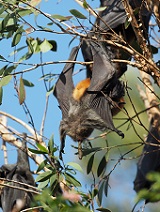
Determining the diet of flying-foxes can help to manage their positive and negative impacts, but traditional methods are time consuming. In this study, we developed an improved method for diet analysis, based on DNA remnants from pollen and other plant parts in the faeces. We identified plant species from the diets of three species of flying-foxes, mostly in the genera Eucalyptus, Melaleuca and Corymbia, and demonstrated that this method will be useful in future research analysing the diet of flying-foxes.
Photo by Adam McKeown.
ZO20085 Abstract | ZO20085 Full Text | ZO20085PDF (827 KB) | ZO20085Supplementary Material (439 KB) Open Access Article
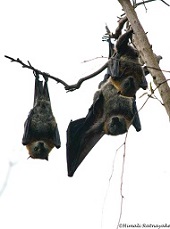
The variation in fur properties of flying-foxes can help us understand why there are differences in survival rates among different species, sexes, and ages during extreme heat events. We found that there were distinct differences in the length, depth, and solar reflectance of fur among different species and demographics, which can cause differences in the experienced heat load. Thus, understanding exactly how interactions between fur properties affect heat transfer can help us explain the higher mortality of some species and demographics.
Photo by Himali Ratnayake.
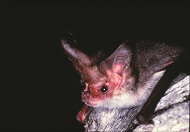
Bats that roost in tree hollows are dependent on sufficient hollows being available to support their behavioural pattern of shifting roost site regularly. Two common and widespread species, the lesser long-eared bat and Gould’s wattled bat, showed complex patterns of roost use that varied between and within species. To support populations of bats in rural landscapes of south-eastern Australia, relatively large numbers of hollow-bearing trees in close proximity are required, incorporating a range of hollow types, particularly those preferred for breeding.
Photo by Lindy Lumsden.
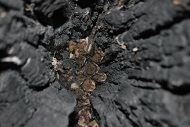
Mature forest availability and spatial arrangement shape how bats use the landscape. Radio-tracking different species during the maternity season revealed the importance of retaining mature forest at multiple spatial scales. These findings provide insight into the type, amount and spatial arrangement of mature forest used by different bat species in a timber production landscape. By understanding the effectiveness of forest retention measures, on-ground forest management can be improved in the future.
Photo by Lisa Cawthen.
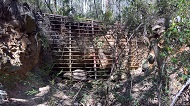
Derelict mines can provide habitat for cave-roosting bats but are often grated to prevent human access, with little known about the long-term responses of bats. We assessed the long-term effects of grating on bats and found that although there was rapid habituation to grated mines, altered flight behaviour was present decades after grating and there was little use of these sites by threatened species. This suggests that alternative management of derelict mines is required to conserve threatened bat roosting habitat.
Photo by Leroy Gonsalves.

Seasonal population changes of Miniopterus orianae oceanensis at one of the three large New South Wales maternity colonies (Church Cave) were studied from December to March every year for 12 years when adult females were resident at a maternity site. Five key periods were identified: (1) adult arrival, (2) adult peak, (3) juvenile independence, (4) adult-juvenile peak, and (5) autumn migration. The average duration of the adult peak period was 38 days. All other periods lasted ~14 days.
Photo by Alex Pike (DPIE).
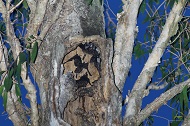
The bare-rumped sheath-tailed bat is listed as a threatened species under Australian national environmental legislation. However, it has been difficult to identify from echolocation calls, and surveys are still helping to define its distribution in Australia’s remote north. Based on an intensive field survey and acoustic analysis of reference echolocation calls, we present a summary of characters and criteria that can assist with detection and subsequent identification.
Photo by Mikey Kudo.
 , Sylvia Clarke, Aimee Linke, Annette Scanlon, Philip Roetman, Jacqui Wilson, Alan T. Hitch and Steven C. Donnellan
, Sylvia Clarke, Aimee Linke, Annette Scanlon, Philip Roetman, Jacqui Wilson, Alan T. Hitch and Steven C. Donnellan
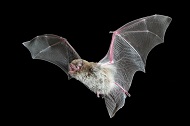
In the Murray–Darling Basin, knowledge gaps exist on populations of insectivorous bat species. We implemented the most intensive insectivorous bat survey ever undertaken of the South Australian part of the system with the help of citizen scientists, and doubled the number of bat species records within just two years. The records are available through the Atlas of Living Australia, are informing government policy, and prompted management actions benefiting bats on private lands.
Photo by Terry Reardon and Steve Bourne.
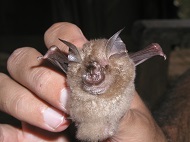
The leafnosed bats (Hipposideridae) and horseshoe bats (Rhinolphidae) are of considerable scientific interest both because of their highly sophisticated echolocation system and increasing evidence of their role as natural reservoirs of emerging coronaviruses. Here I compare and contrast the use of echolocation in the two families and examine whether differences in the echolocation system have resulted in differences in their foraging behaviour, habitat and diet.
Photo by Damian Milne.
ZO20047 Abstract | ZO20047 Full Text | ZO20047PDF (345 KB) | ZO20047Supplementary Material (186 KB) Open Access Article